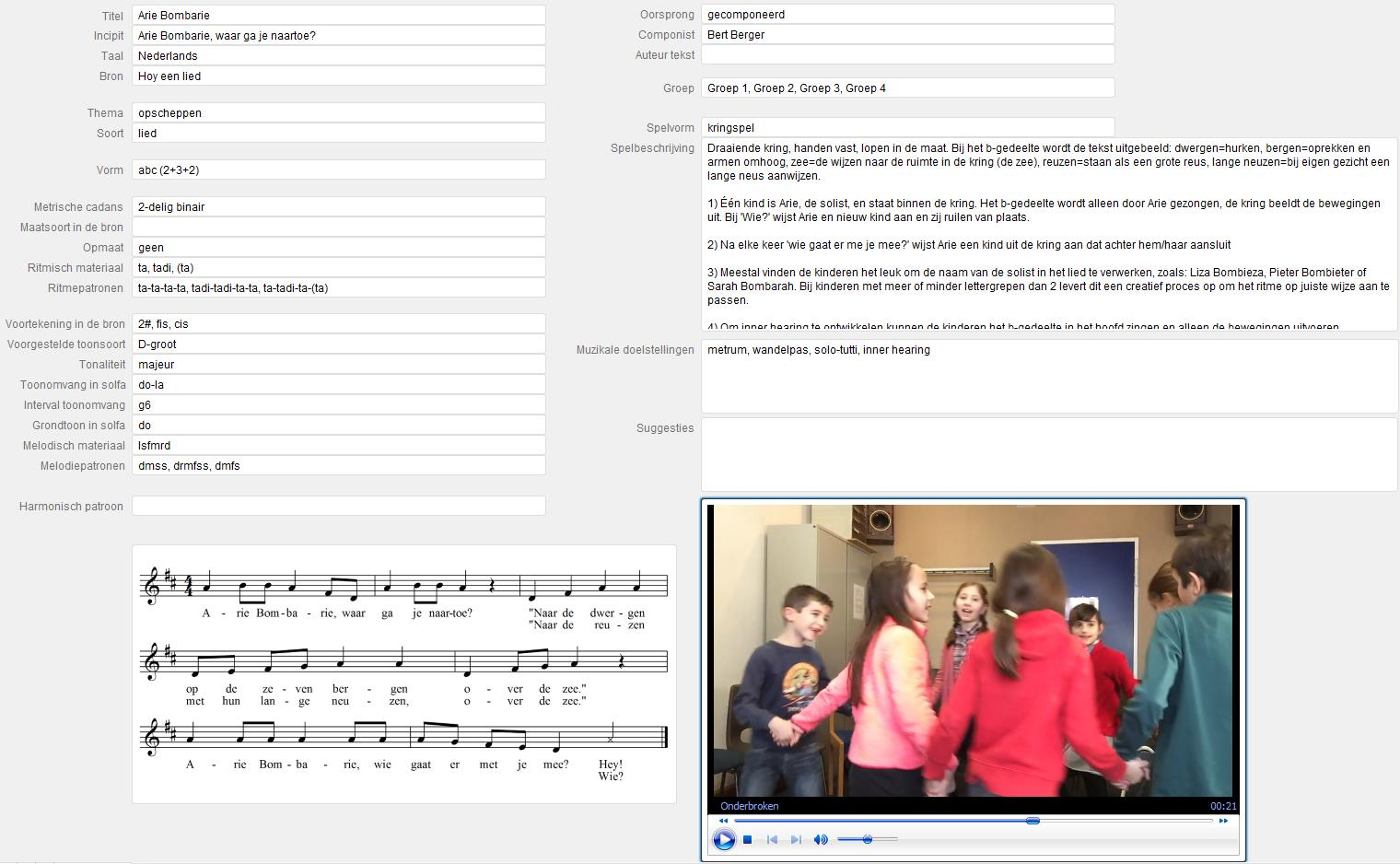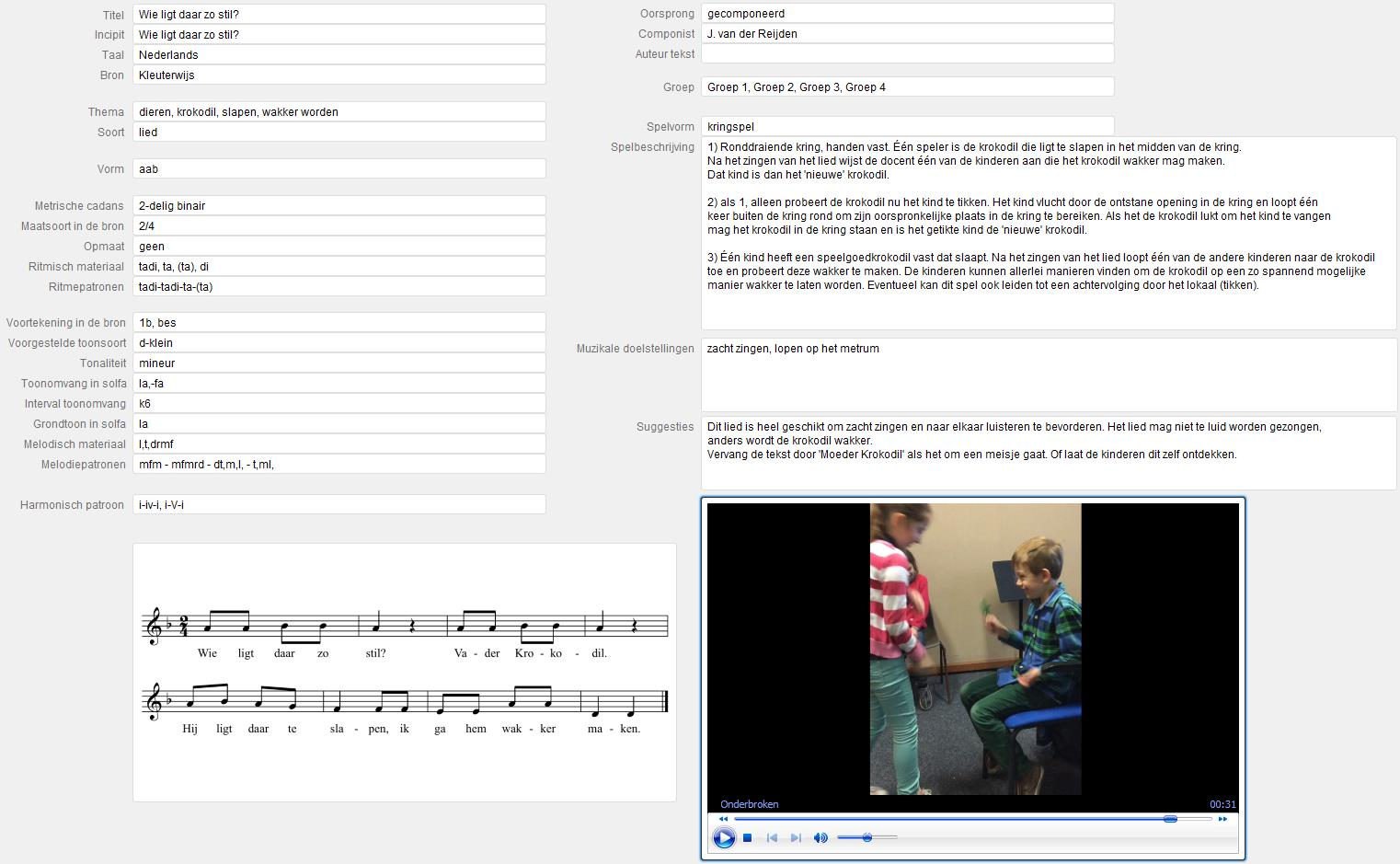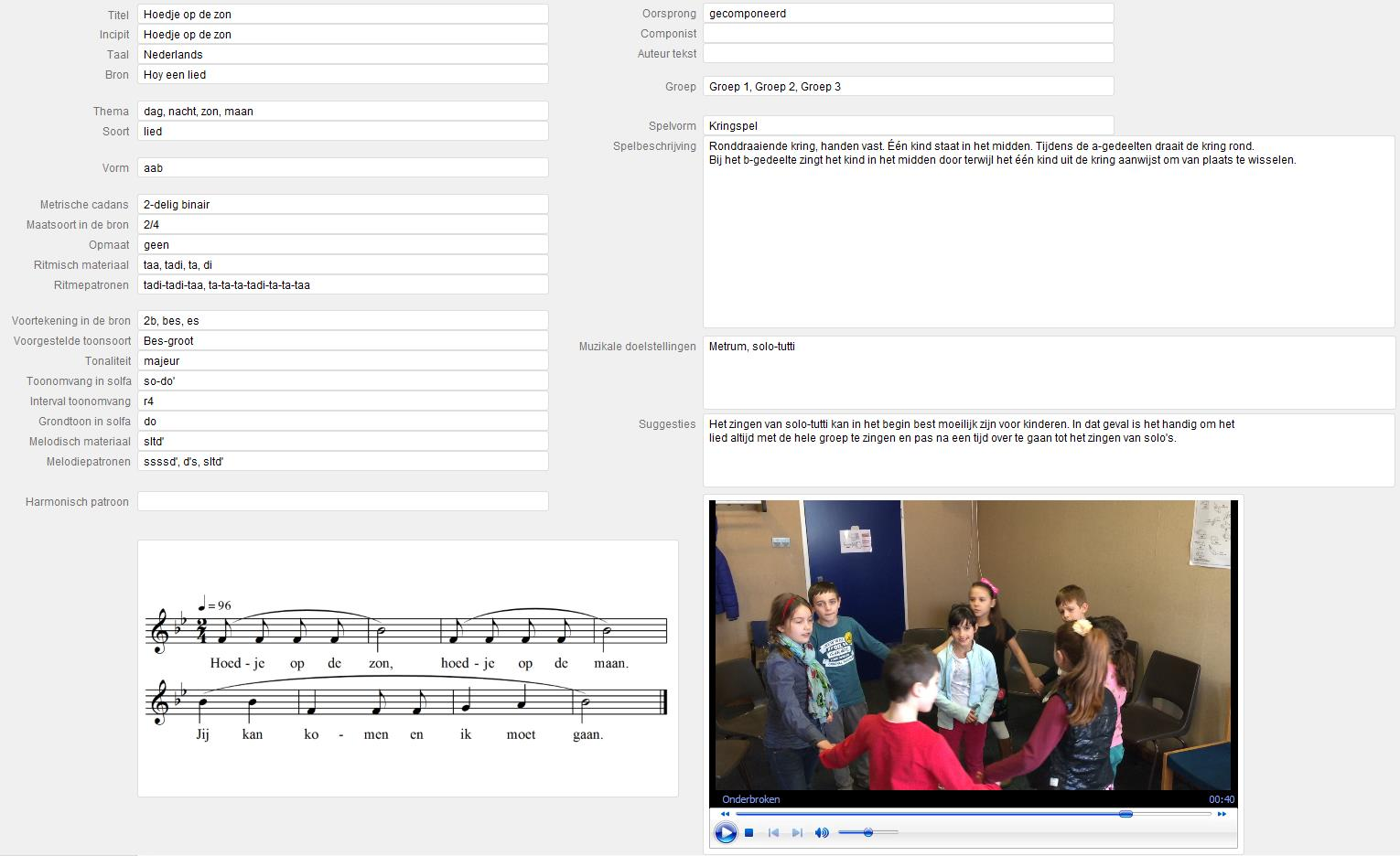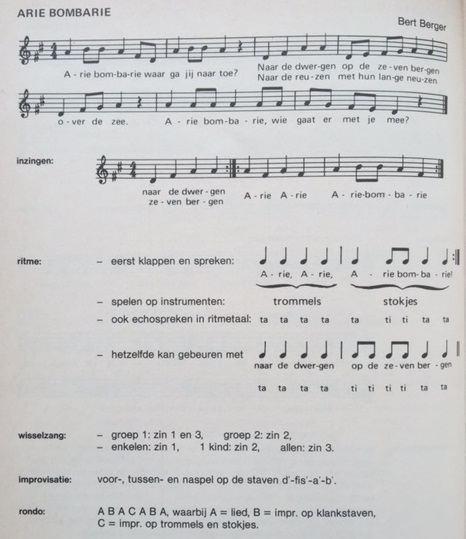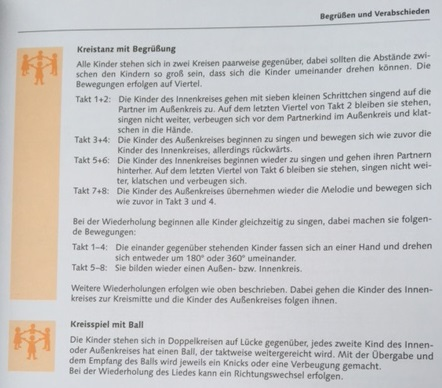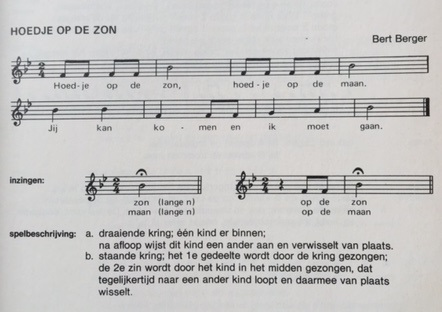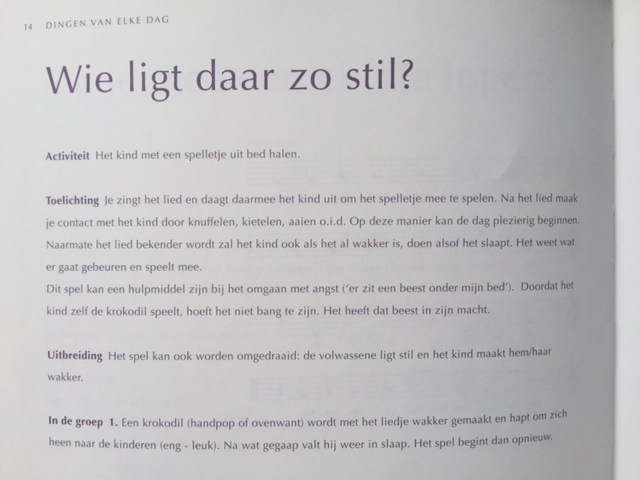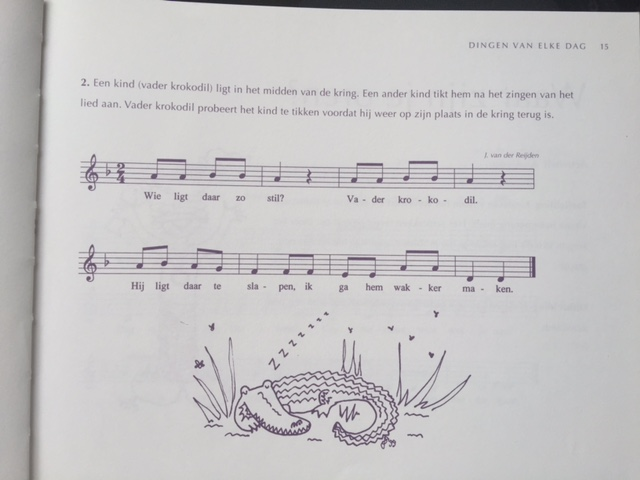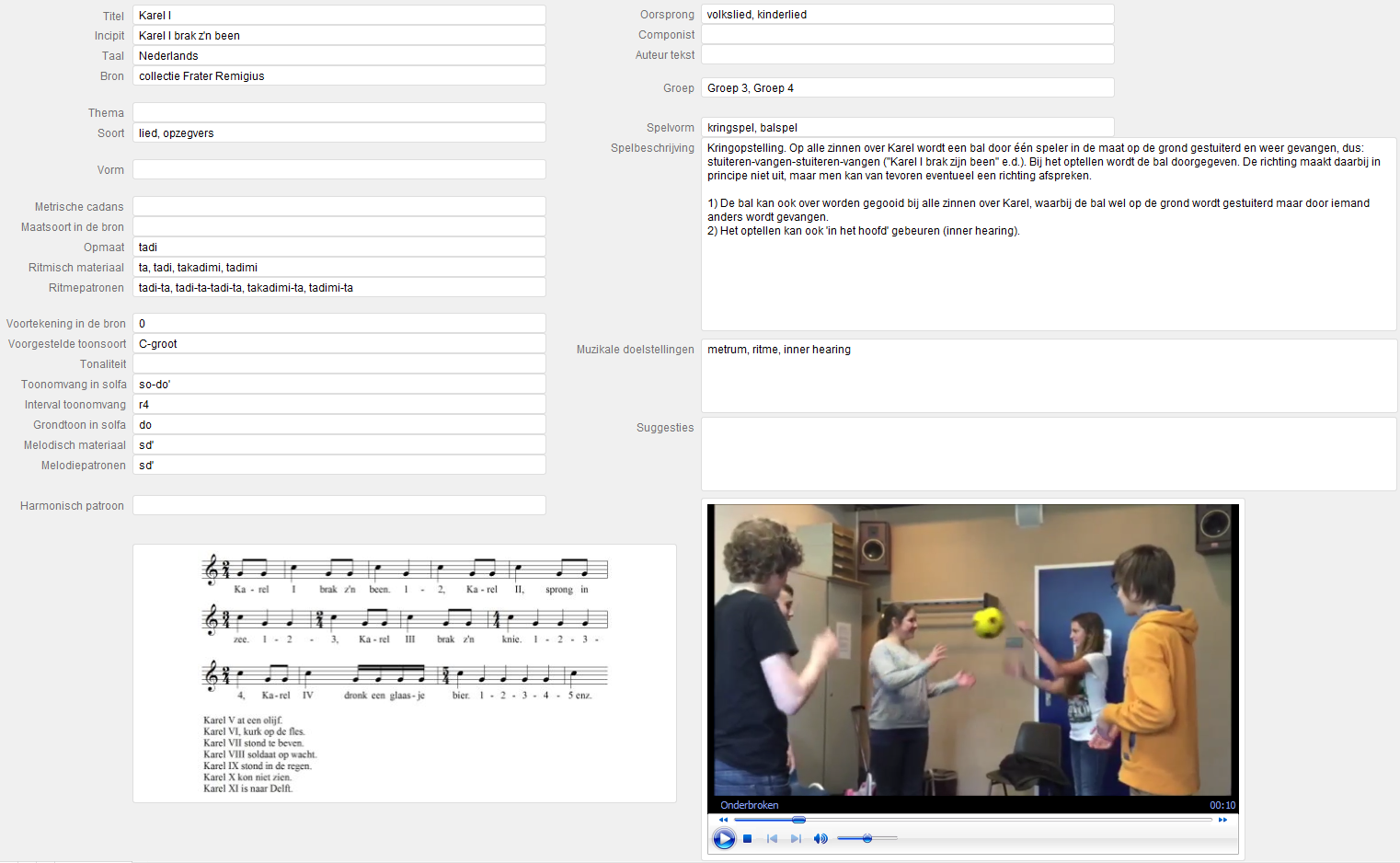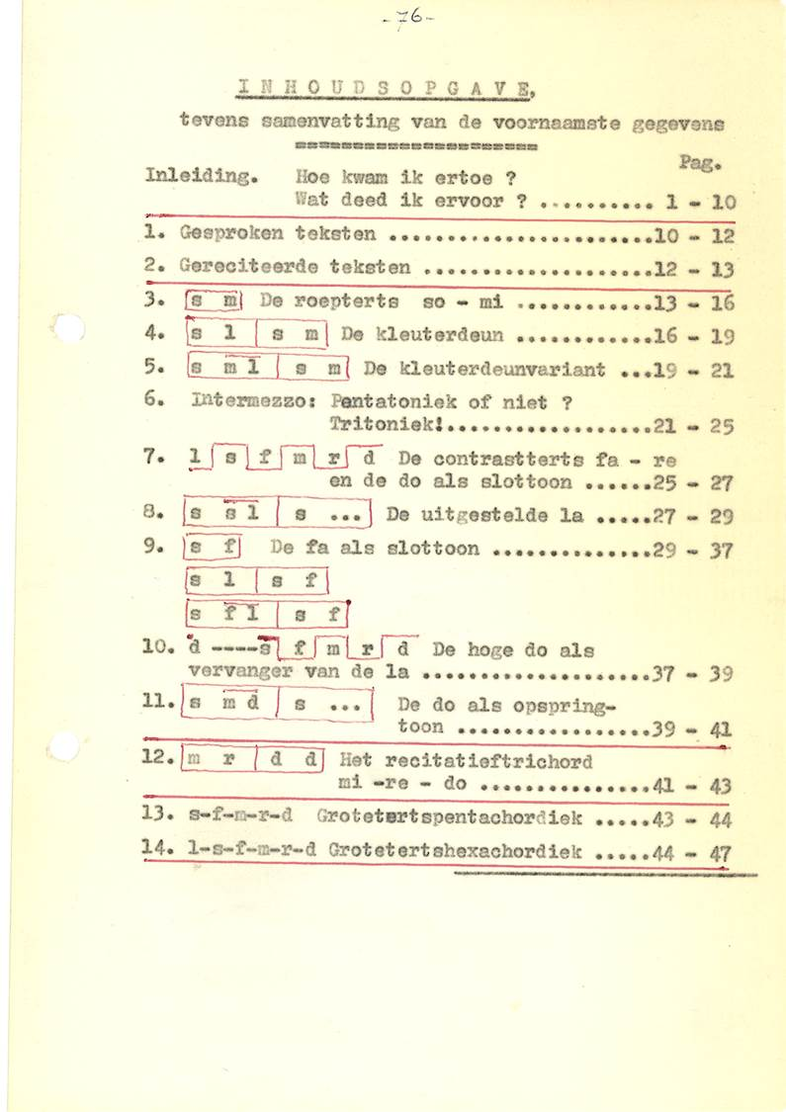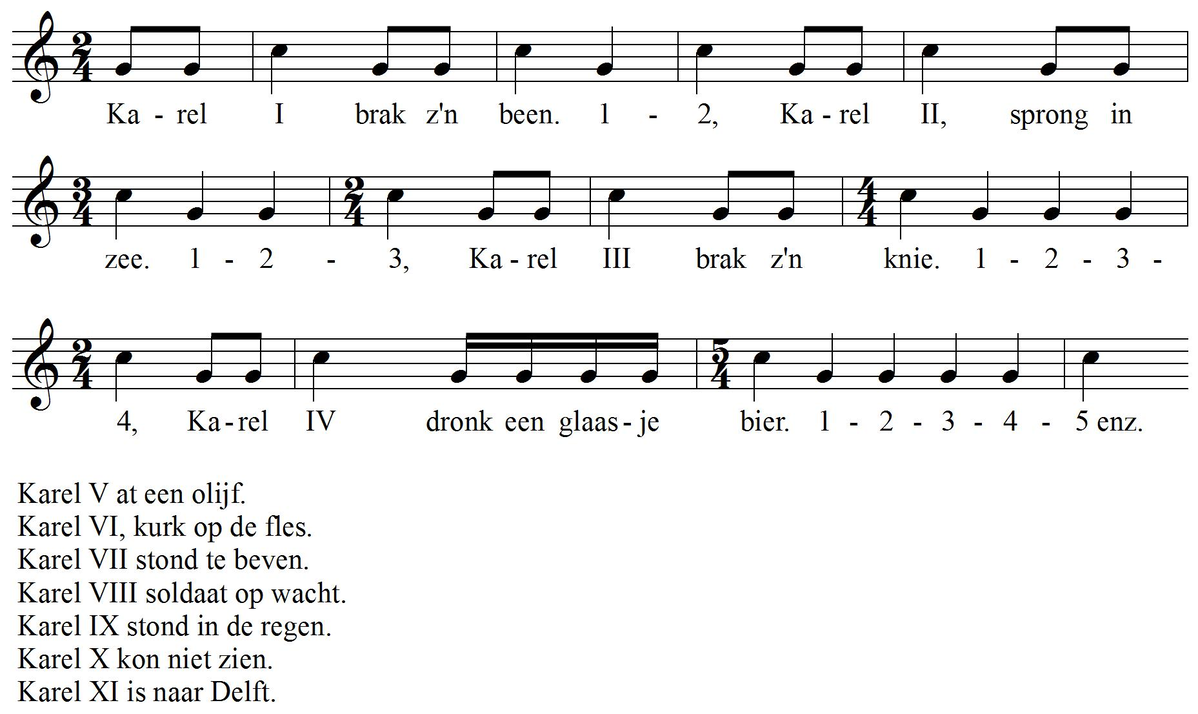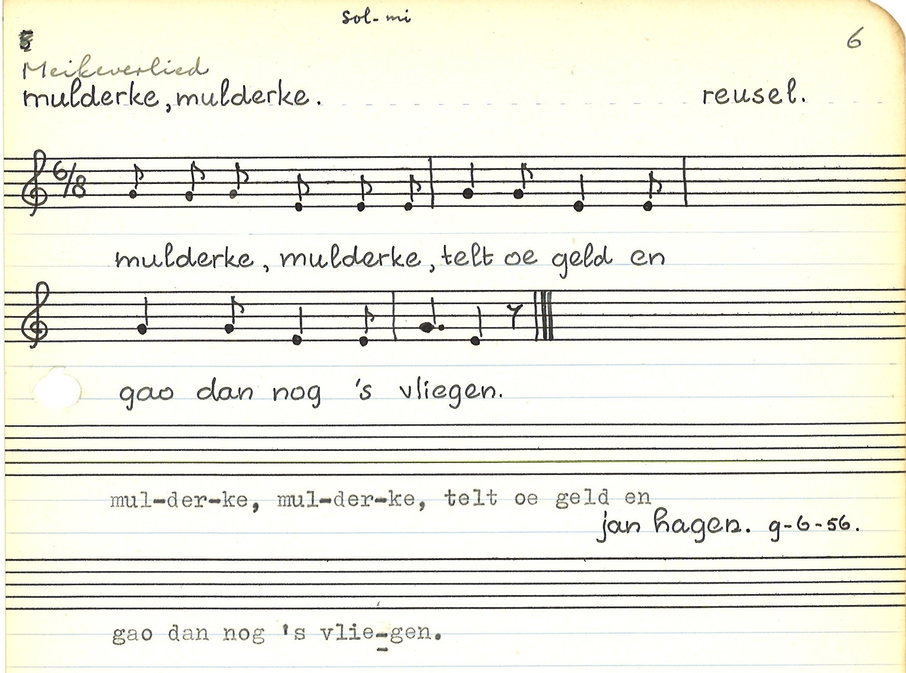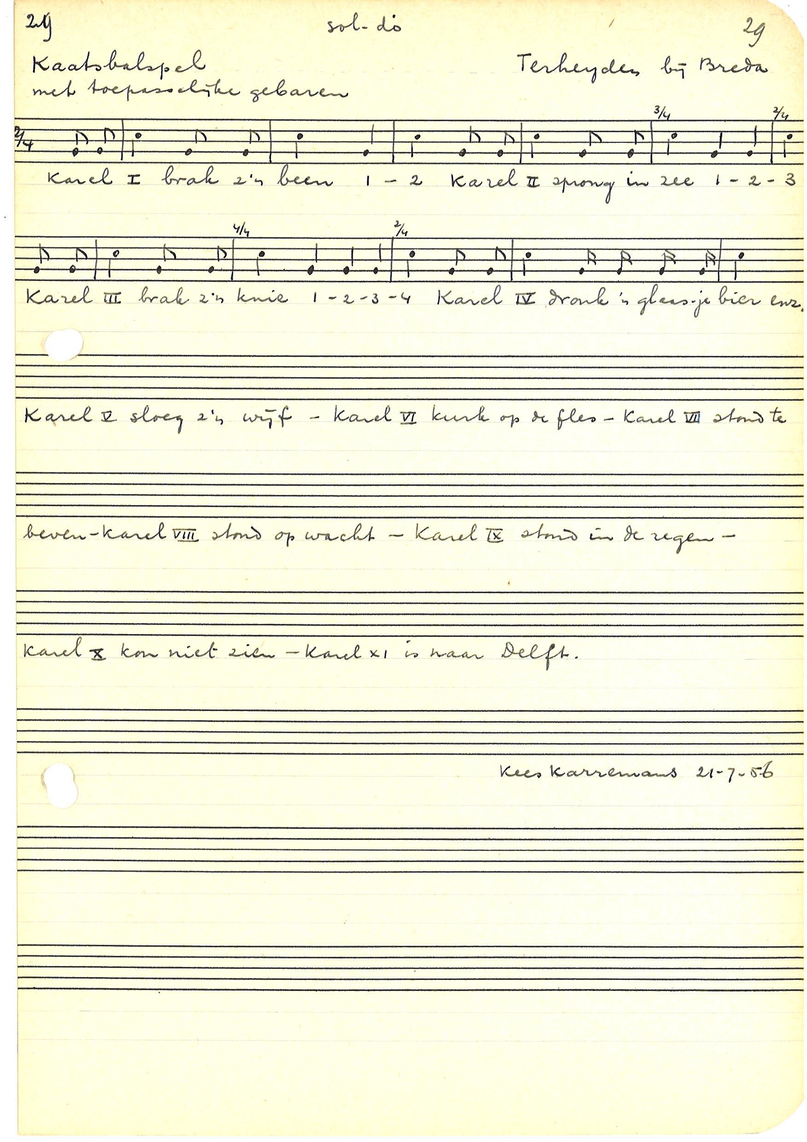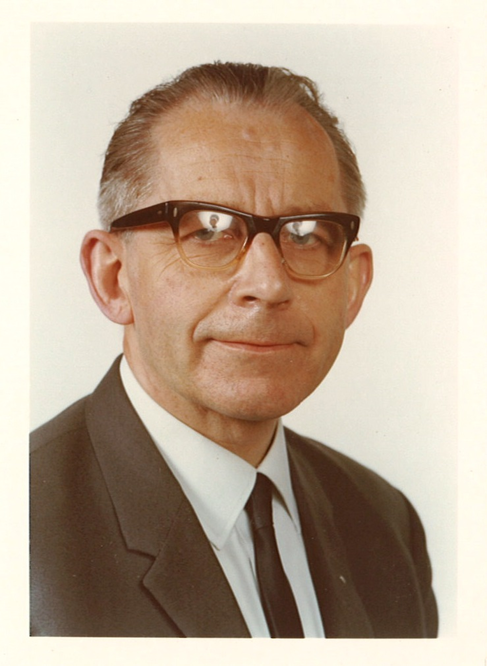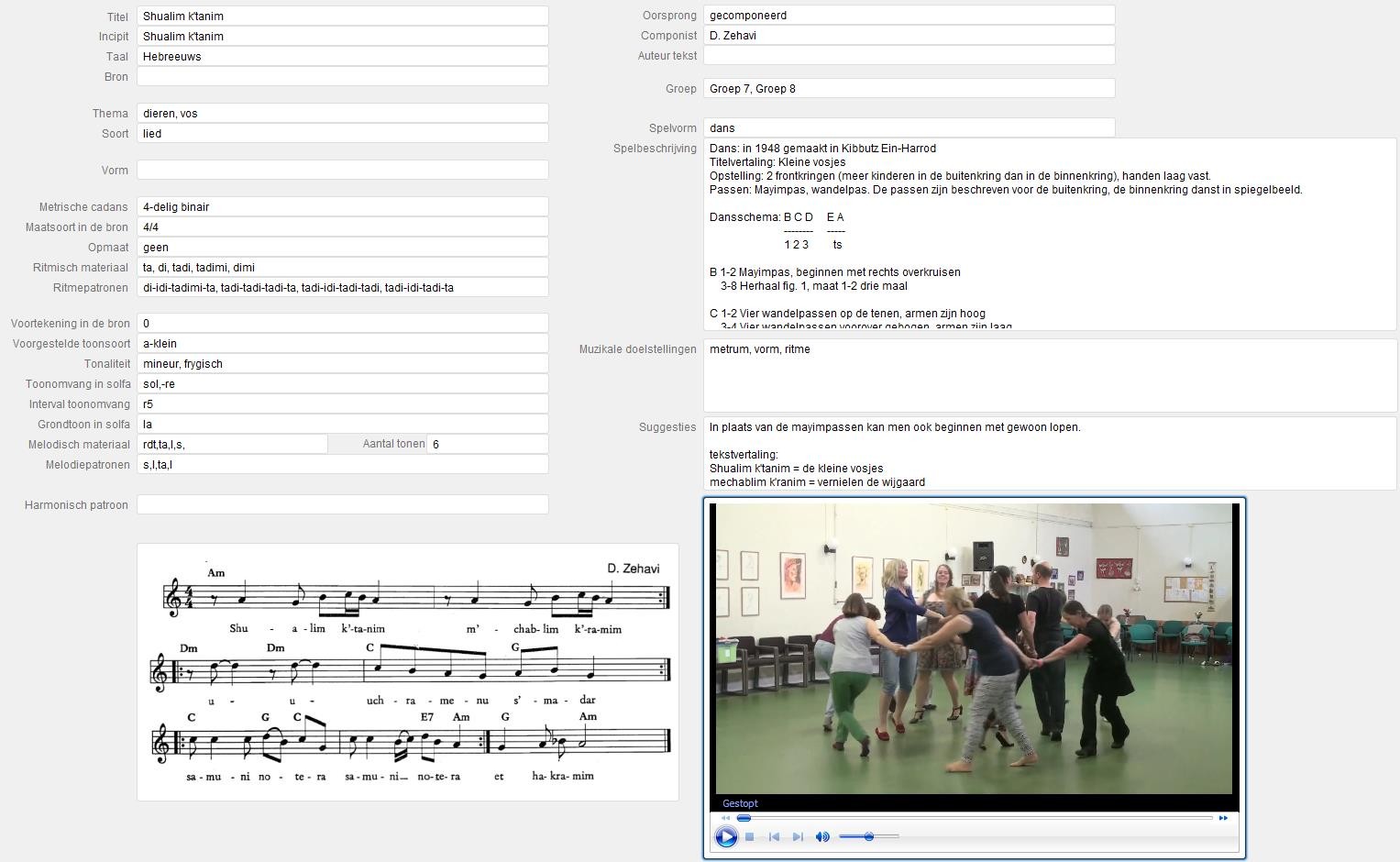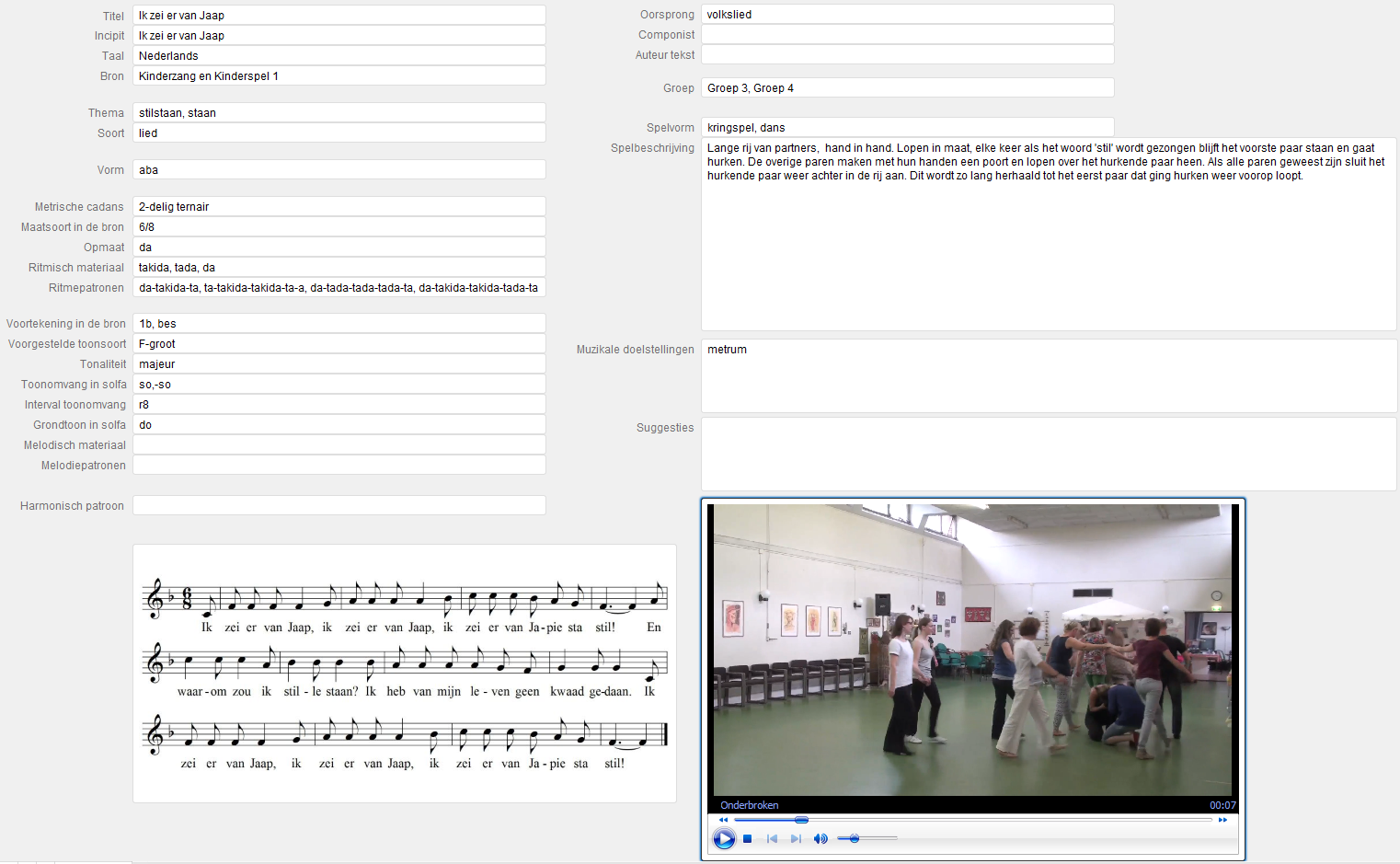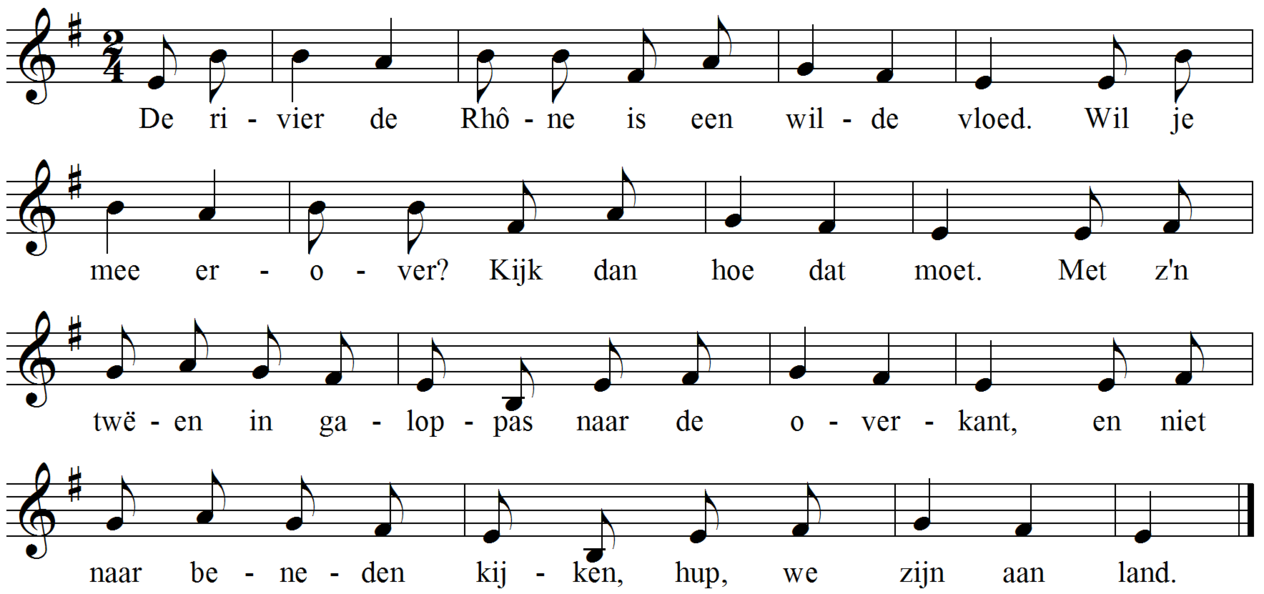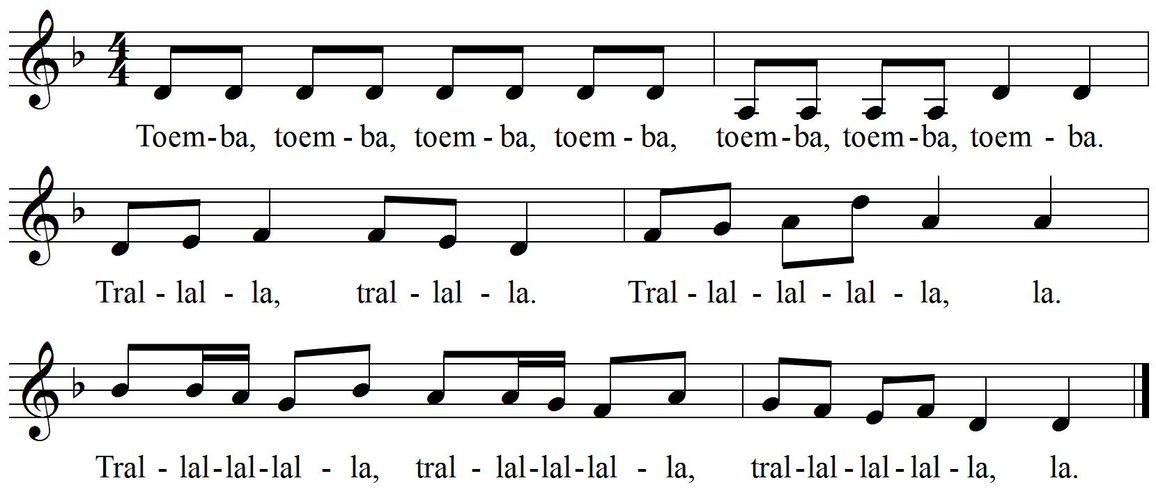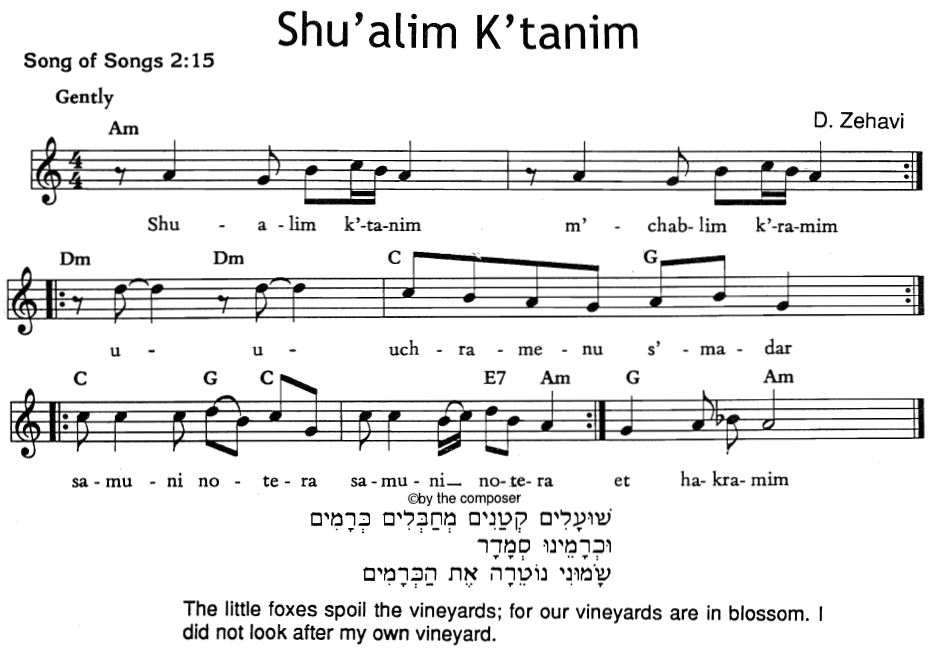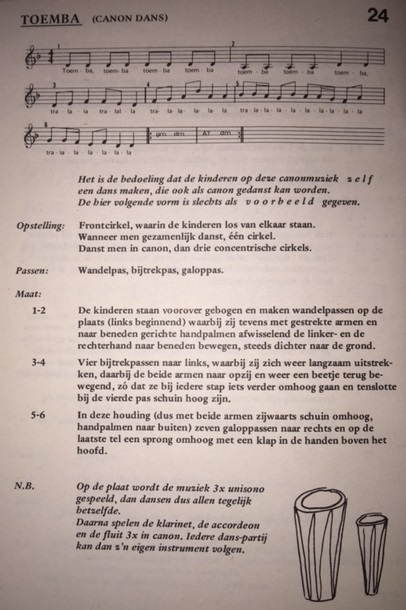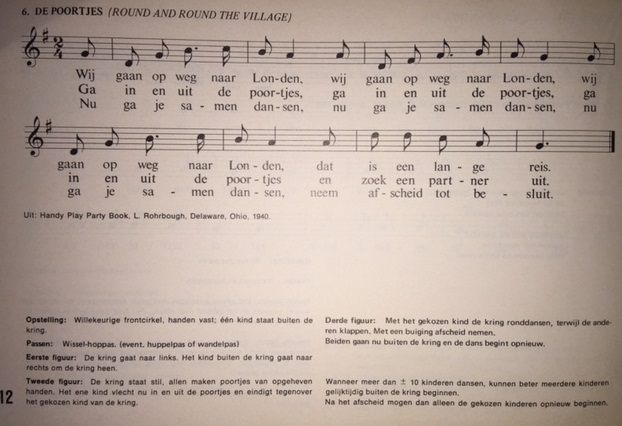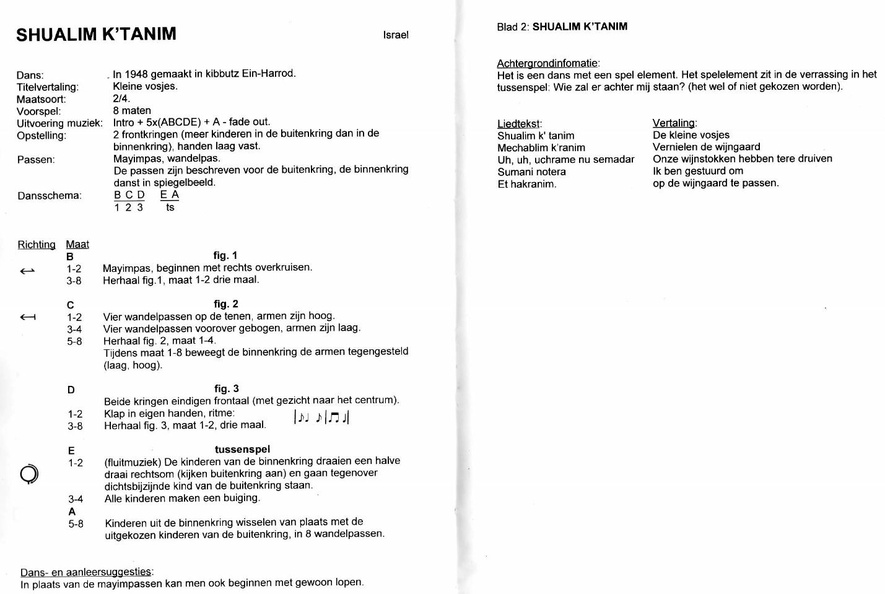Research Fields
In this chapter I give further details about researching song books, a specific collection at the Meertens Institute and the Dancing Workshop.
Song Books Meertens Institute - Collection Friar Remigius Dancing Workshop
The preparation of musical learning by singing relevant repertoire is the core idea of Kodály-inspired teaching. Children should always be prepared through a large variety of song material concerning toneset, rhythm patterns, meter, dynamics, tonality, etc. How the curriculum unfolds itself to the student is not exactly the same as how the song material is chosen. For example, many songs may contain more than two different tones, but in the curriculum we might teach feeling consciously the difference between so and mi. To aurally distinguish these two tones a lot of preparation has to be done with movement: moving up and down to the melodic contour of the songs, expressing the shape of a melody with body movement. And – in a later stage – following the melodic shape of a two-note so-mi-song with handsigns will prepare aural awareness of staff notation. But that does not mean that all the songs that are sung with the children are only so-mi-songs. Then we would limit the children in their musical experience for reasons of the curriculum. The idea is to take out so and mi as two contrasting pitches out of the large variety of the song material that is offered to the children. So the curriculum does not represent the musical experience of the children but the actual musical learning proces concerning – for example – aural awarenes and musical literacy.
Studying song books will mean to search repertoire for certain teaching goals by finding musical elements in a song that are suitable for presenting them to the children after they have learned and completely know the song. So looking for two- or three-note songs in existing song books does not mean that only two- or three-note songs should be sung with the children. As I mentioned above, the curriculum may not limit the children’s experience. The curriculum only gives a choice which elements are first taken out of the rich experience to make conscious[1]. So by creating a curriculum, also providing a rich musical experience should be taken into account. Of course young children are limited concerning the singing voice (vocal range, tessitura, articulation tempo, etc.), which should also be taken into account.
In the bibliography I summed up many song books which I used for this research and which I studied seeking suitable material. The criteria were as follows:
- rhythmic and melodical patterns that are possible to isolate as a target patterns without destroying the text unit
- clear presence of musical parameters (dynamics, tempo, pitch, etc.) and the connection to the meaning of the text (such as slow – snail, high – helicopter, soft – sleeping, etc.).
- possibility to use body movement to experience certain musical layers of the song (beat, meter, rhythm, pitch, dynamics, etc.), so preferably singing-games
- solo-tutti-singing (also to prepare inner hearing)
In the first instance, this part of the research was not limited to a certain age group. The main focus was to get an overview of the material which is available. Concerning the anlysis of the songs I made up an indication for which age group the song/game could be suitable, but this is rather for practical reasons. In future research songs could be collected for specific age groups.
The songs which I found were collected in a searchable database, developed with File Maker Pro.
Database – Example “Salibonani”
In the song collection “Lieder, Spiele, Kanons” I found the song ‘Salibonani’ from Zimbabwe, Africa. It is a traditional song to greet each other in the morning, thus a Good-Morning-song.
In the publication many suggestions are given about voice training, clapping games, a ball game and even dance movements. So the different types of games underline different musical layers which the song offers.
For this song I chose to simply use a more classical clapping pattern to make the beat/meter feelable. In particular the syncopation is a very typical rhythmical element which is performed while clapping the beat/meter at the same time (polyphonic activity). Another characteristic is the possibility to isolate seperate rhythm patterns from the song without ‘cutting off’ phrases or words from the text, which would result in ‘unlogical’ patterns. Every bar of the song can be clapped separately as a unique rhythm pattern. Those can first be aurally recognized as a part of the song and later by the according rhythm language. Once the rhythm language is learned, the same patterns could be aurally recognized in other songs where they occur. So again it is obvious: choice of repertoire, and also the possibility to sequence the repertoire for musical learning is of tremendous importance.
So after a musical methodological analysis of the song I add it to the database:
Next to the score an example video of the game is provided. Other musical criteria are form, meter, upbeat, rhythm- and solfa-patterns, toneset, melodic range, tonality and harmony. Besides, type of game, broader musical goals and extra suggestions are provided. The aim of the database is to be able to search for comparable songs by entering congruent critera. So, for example, the syncopation is also part of the song ‘Epo i tai tai’:
By searching for the rhythm pattern tadi-idi this song will be found and presented. Like this it is easy to sequence repertoire for practicing.
Database – Example ‘Vader Krokodil’
The next example is a little Dutch children’s song with another type of game. Here silence, especially the tension which comes from silent expectation is felt. The song is very suitable for soft singing because the crocodile is sleeping and could be dangerous when woken up. There two rests in the melody where the children perform a soft ‘ssh’-sound to remind each other to be quiet. I found this song in the publication “Zingen met likkepot”.
Again we can see that some suggestions are given for playing games, but in this case there is not really a game which underlines musical elements of the song. It more about free expression of the text. The idea of a circle game could be worked out towards feeling the beat by letting the circle turn around walking on the beat. Also this could be extended to a classical chasing game (one child wakes the crocodile, the crocodile runs around the circle after that child to catch it).
The song is especially suitable to prepare the musical rest, not as a symbol, but as a felt beat of silence inside. The first two bars can be isolated as the rhythm pattern tadi-tadi-ta-(ta), and because of the repetition it can also be performed in two groups after each other or as solo-tutti (or even tutti-solo). Besides, it is a song in the minor key, which should also be part of musical experience. This is how it appears in the database:
Database – example ‘Arie Bombarie’

In older Dutch songbooks we can still find references to rhythm language, as we can see with the song ‘Arie Bombarie’ from the pulication “Hoy een lied”, first published in 1974. Interestingly many methodological steps are mentioned throughout the book with nearly every song, mostly without any further connection to a curriculum.
Anyhow, rhythm patterns are isolated by speaking and clapping, played on instruments and spoken in rhythm language. Also responsorial singing is suggested. Suggestions are given for musical improvisation with a 4-toneset on a xylophone (d-f#-a-b) as well as an activity for the formal structure extending it to a rondo. For this reason it is particularly interesting to study not only recent song collections for elementary schools but also the older methods. That’s why I started also searching for song collections which are only available through second hand shops using websites such as boekwinkeltjes.nl, abebooks.com or antiqbook.nl.
This song is particularly interesting because next to rhythmical patterns it also gives an opportunity for isolating melodic patterns like s-ll-s-m, d-m-s-s, dr-mf-s-s or d-mf-s. In practice I have actually chosen to move with the children in a circle (holding hands) while walking the beat. Then one child could be in the middle to be ‘Arie Bombarie’ and sing solo in the middle section. It is possible to extend the game to make a chain after the soloist so that there will be a group in the middle and one which forms the circle. After a while it is necessary to break open the circle due to the larger middle group. By this the song is constantly repeated and practized, as well as the movements that go along.
The song appears in the database like this:
Database – example “Hoedje op de zon”
The song “Hoedje op de zon” is a good example of a short 4-note-song with a clear aab-form, being quite similar to a Satz. So this song prepares very universal principles of phrase building. Again the children will move to the beat and have an opportunity for responsorial singing. Concerning rhythm patterns the song is suitable to teach ta-a, a sound lasting two beats. And also the fourth s-d’ is prepared. Interestingly, in the second half it is inverted to d’-s, so both directions are practiced. In the last two bars the fourth is ‘filled up’ with ascending diatonic steps which makes it easy to count that it is a distance of four tones. So this song is a concentration of many different aspects of musical learning and is, so to say, music theory in a nutshell.
This is how the song looks like in the database:
[1] I am convinced that this is very comparable to language learning. From the first moment on children are surrounded by the full language: parents are talking to each other, they are speaking to the child, they are singing songs to the child, etc. As the childs physical abilities grow, there is also more and more physical control of imitating these sounds. From babbling up to the first single words, children learn to imitate sounds from a much more complex environment than they can yet actively take part in. But without that environment there would be no need for developing complex language skills at all. And, on the other hand, it would be rather ridiculous if the parents would only babble to each other or to the child for the benefit of teaching how to speak the language.
Meertens Institute - Collection Friar Remigius
From summer 2014 on I have been several times at the Meertens Institute Amsterdam. It was established in 1926 as a research institute of the Royal Netherlands Academy of Arts and Sciences since 1952. The main focus is the study and documentation of the diversity in language and culture in the Netherlands.
In early 2014 I discovered a publication by Prof. Dr Louis Peter Grijp, “Van Boekenoogen tot Frater Remigius. Kinderliedverzamelingen in het Meertens”. In the short article, Louis Grijp gives an overview of special collections of children’s songs which are preserved in the Meertens Institute. Especially the collection by friar Remigius seemed interesting to me, because he had collected songs from oral tradition and had ordered them according to tonesets using relative solmization. Or – as Louis Grijp puts it:
“The about 600 songs are musically ordered by friar Remigius. According to his ordering there are first rhymes, then the songs on one tone followed by the ones with one interval (so-la and so-mi) and so on. This shows a typical approach of musical didactics [...].”
At the Meertens Institute I met Louis Grijp and we had an interesting conversation about the role of traditional Dutch music and literature in the current music education in Dutch elementary and secondary schools. I was allowed to research the actual source of friar Remigius’ song material. After some testing it was even possible to scan the entire handwritten source to make it digitally available for further research.
The collection of Friar Remigius
Josef Lambertus Leonardus Heesbeen (Friar Remigius) was born on February 13, 1914, in Helvoirt, The Netherlands. From 1932 on he was working as an Elementary School teacher and teacher trainer in different subjects among which Music. In 1961 he graduated as a school music teacher at the Brabant Conservatoire. In his teaching at the Elementary School he used mainly folk- en children’s songs. He collected children’s songs by asking students from the teacher training to sing the songs they knew so he could write them down. Sometimes the students wrote down the melodies themselves. With every sheet the name of the student who sung or notated it is given as well as the place where the student lived during his or her childhood.
The song ‘Mulderke’ is a two-note so-mi-song which was traditionally sung by children playing with a cockchafer or May-bug (‘Mulderke’ in Dutch). The song was sung by Jan Hagen on June 6, 1956. Reusel is the place where he sung the song being a child, probably playing the typical game with a cockchafer[1]. The Meertens Institute offers their research for the Dutch song heritage online at liederenbank.nl. This website presents a searchable database of songs from different collections, some of them recorded and transcribed comparable to Friar Remigius’ work. The song ‘Mulderke’ appears there like this:
The source is a recording of that song from September 9, 1968. It is interesting to see that the words are the same but the melody is completely different. This shows that there must have been an oral tradition of passing on folks songs in The Netherlands.
So I went through the 600 songs friar Remigius has collected with the aim of finding repertoire for my teaching. Of course older song material might have old-fashioned texts which could not be sung like this anymore. A good example is the song “Karel I brak z’n been”, accompanying a ball-game:
The text says “Karel V sloeg z’n wijf” (Charles the Fifth beat his wife). Of course this is impossible to sing this in a classroom in present times. But on the other hand the melody and its change of meter is very interesting from an music educational point of view. And it is a two-note so-do’-song, so it can be used for teaching or practizing that particular interval. Besides, different rhythm patterns are trained with the rhyme on the numbers. And the idea of making every new “Charles” in the song one beat longer gives an irregularity which stimulates the experience of meter changes. A solely text-dominated view on song material would immediately lead to skipping this song to be part of a song collection. This would be a pity because of the musical elements which are so strong. So I chose to reformulate the tekst a little bit so that it is suitable for our times:
In this adaption Charles the Fifth is eating an olive (“at een olijf”). The other words are fine. I invented a little ball-game with this song which might come close to the original game.
Game description: the children stand in a circle, one of them is holding a ball. Every time when the numbers are sung the ball is passed in the same direction (decide Right or Left in advance). When the other words are sung the ball is bounced on the beat to the ground starting on every “Ka-“ from “Karel”: bounce, catch, bounce, catch. With the first number “1” the ball is passed to the person right or left as long as the counting is lasting. The person who receives the ball on the last number is the one who starts bouncing it again. A nice variation is to change direction of passing the ball when starting to count up to an odd or even number.
This is the entry in the database:
From an educational point of view several things are trained while playing this game. Of course the beat is felt strongly with the movement while counting. At the same time children have to adjust the tempo of bouncing and catching the ball to the beat of the song. This trains the awareness of tempo and beat as well as the movement between the beats. Of course this is all done while singing the song and articulating the words in different rhythms. And if we change direction with odd or even numbers children have to anticipate which ´Charles´ comes next, so they have to think ahead. This stimulates the development of polyphonic skills and polyphonic thinking. At the same time the perfect fourth is practized ascending and descending. Also coordination and social skills are part of this singing game, so it addresses the person as a whole. Inner hearing could be developed by leaving out either the counting or the other words while the ball-game is still performed. I believe that a creative and inventive view on older Dutch song material can bring up valuable singing-games for Dutch music education.
[1] This song was sung after catching and hiding a cockchafer with both hands. Probably because of darkness and warmth of the hands the bugs were not flying immediately when released, so they had to be thrown to the ground. This has been a typical and traditional children’s game in The Netherlands. (Source: Martin van der Donk en Teo van Gerwen, De wondere wereld van de insecten, AW Sijthof, Alphen aan de Rijn, 1981, Pagina 134)
Dancing Workshop
An essential source for physical movement in combination with music is of course folk dance repertoire. On July 6, 2014, I organized a dancing workshop together with the experienced dance pedagogue Annemieke van Wijk. The aim was to experience practically older and also recent Dutch singing games and international folk dances. In several meetings Annemieke suggested repertoire reaching from old Dutch singing games up to (folk) dances from different countries. Often these games and dances are a preparation, not only for musical learning and developing musical skills. They are often also preparing (folk) dancing skills like walking in a row, walking in two rows with a partner, walking four steps to the right, then to the left, walking forward and backward, etc. Often these movement patters go along with the musical phrase building, so that’s why choosing this kind of repertoire for music lessons is so interesting. With dancing we can learn to move according to the form, experience it with our bodies while singing the song. If the movements become more complex we can also work with audio-cd’s to move along. Anyway, also then we have to listen to the recording to control the movement and synchronize. I strongly believe that this is an indispensable skill which is essential for everyone te learn.
Dancing workshop – example ‘Ik zei er van Jaap’
The game ‘Ik zei er van Jaap’ with its aba-structure teaches children to walk in a circle with a partner. Every time when the word ‘stil’ (=silent) is sung the first couple is crouching while the row passes over them forming portals with their arms. When all couples have passed, they join in again in the back of the row. This singing game is very suitable to walk in the beat, also the musical form is experienced because – while singing – everyone has to be aware when to crouch. The song is already very old, it appears in the “Nederlandsche baker- en kinderrijmen” bij J. van Vloten en M.A. Brandts-Buys published in Leiden in 1894.
Dancing Workshop - example 'De poortjes'
The dance "De poortjes" (the portals) does not only involve walking on the beat, it also invites to clap the beat while standing still. Here the variation is especially interesting, because next to the circle activities there is room for individual movement. Also walking through the portals, choosing a partner and dancing around within the circle makes this dance interesting for the older children. I would estimate an age from 6 to 9.
Dancing workshop - example 'Toemba'
The canon 'Toemba' is accompanied by an interesting circle dance which is obiously a visualization of the polyphonic canon structure. It is a three-part canon, so there are three groups with different actions:
Next to polyphony, the melody is very suitable for isolating patters for rhythmical learning, particularly because of the short syllables of the words: tadi-tadi-tadi-tadi, tadimi-tadi, tadi-tadi-ta-ta, tadi-ta-tadi-ta. With the younger children, this dance could be performed without the canon. Then only the rhythm patterns with tadi en ta could be used, perhaps for practicing this patterns which were already learned through other songs. With the older children polyphony can be added, and the rhythm pattern tadimi-tadi could be presented. Also little melodic motives could be trained. The first two bars turn down from l, to m, and back. In the next bar the melody turns from l, to d and back, so t, is used as a passing tone in both directions: l,t,d and dt,l,. In the last two bars the sequence is particularly interesting, so this topic could be introduced by this melody: f-fm-r-f is followed by m-mr-d-m. This could be trained from the understanding of the structure of the motive: one repeating tone, then two seconds down and a third up. By handsigning and pointing to the solfa-syllables on the blackboard, this motive could be transposed to other beginning tones than f and m of the (aeolian) minor scale. As we can see, this melody offers so many possibilities for presentation of musical topics - of course after sufficient preparation. Again, this song offers music theory in a nutshell.
As always in quality music teaching, there is room for individual expression and creativity. In the dance description it says that this dance is just an example, and that children should work out their own dance movements on the three parts of the canon. This requires certain skills which must have been developed before. The publication where this dance was printed comes from 1983. I find it most intriguing that children were considered to be able to find their own dancing steps on a canon they can also sing in three parts. In my opinion - regarding the "Handreiking Muziekonderwijs 2020" which I quoted in the beginning - this says a lot about the mentioned decline in music education in the Netherlands of the last thirty years.
This dance appears in the database like this:
Dancing workshop - example 'de Rhône'
The dance 'De Rhône' especially puts the emphasis on musical form or phrase building. The aabb-structure is coming back in the dance movement:
Two groups are lined up, facing each other. On the first a-part, they move four steps towards each other and four steps back. This is repeated on the repeating of the a-part. So the movement actually is also aa. On the b-part the beat is clapped by everyone except one couple which dances through the line formed by the others. This line is the river, and the couple passes the river as the words tell us. Next to rhythmical walking, clapping the beat is involved.
Concerning rhythm patters this song offers upbeat-patterns. This is rather a topic for the advanced learners, this is why this dance is more suitable for higher age-groups. Though, the dance itself could also be pepared in an earlier stage.
This is how the dance appears in the database:
Dancing workshop - Shu'alim K'tanim
One of the highlights of the dancing workshop was the Hebrew-dance Shu'alim K'tanim, the dance of the little foxes. Here, form, steady beat and rhythm are combined. Also social interaction is a big part of it, as partners have to change places. It is danced to an audio-recording, but it could also be sung at the same time.
The song provides many possibilities for rhythmical learning, especially because the clapping of two different rhythms patterns are part of the dance: tadi-di-tadi-tadi and tadi-di-tadi-ta. These become easily aurally recognizable. Besides, the syncopated rhythm of the first two bars is particularly interesting for rhythmical practice, especially because it begins after the beat. The more simple rhtyhm tadi-tadi-tadi-ta in the fourth bar gives an opening for recognizing this pattern learned through other songs. Melodically the last bar is of special interest, introducing the phrygian ta into the aeolian minor melody.
Here is the entry in the database:
